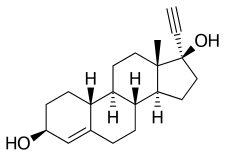Etynodiol
 | |
| Clinical data | |
|---|---|
| Synonyms | Ethynodiol; 3β-Hydroxynorethisterone; 17α-Ethynylestr-4-ene-3β,17β-diol |
| Drug class | Progestin; Progestogen |
| ATC code | |
| Identifiers | |
| |
| CAS Number | |
| ChemSpider | |
| ECHA InfoCard |
100.013.610 |
| Chemical and physical data | |
| Formula | C20H28O2 |
| Molar mass | 300.435 g/mol |
| 3D model (JSmol) | |
| |
| |
Etynodiol, or ethynodiol, is a steroidal progestin of the 19-nortestosterone group which was never marketed.[1][2][3] A diacylated derivative, etynodiol diacetate, is used as a hormonal contraceptive.[1][2] While etynodiol is sometimes used as a synonym for etynodiol diacetate, it usually refers to etynodiol diacetate, not etynodiol.
Pharmacology
Etynodiol is a prodrug of norethisterone, and is converted immediately and completely into norethisterone.[4][5][6] In addition, etynodiol is an intermediate in the conversion of the prodrug lynestrenol into norethisterone.[7]
| Compound | PR | AR | ER | GR | MR | SHBG | CBG |
|---|---|---|---|---|---|---|---|
| Norethisterone | 67–75 | 15 | 0 | 0–1 | 0–3 | 16 | 0 |
| 5α-Dihydronorethisteronea | 25 | 27 | 0 | 0 | ? | ? | ? |
| 3α,5α-Tetrahydronorethisteronea | 1 | 0 | 0–1 | 0 | ? | ? | ? |
| 3α,5β-Tetrahydronorethisteronea | ? | 0 | 0 | ? | ? | ? | ? |
| 3β,5α-Tetrahydronorethisteronea | 1 | 0 | 0–8 | 0 | ? | ? | ? |
| Ethinylestradiol | 15–25 | 1–3 | 112 | 1–3 | 0 | 0.18 | 0 |
| Norethisterone acetateb | 20 | 5 | 1 | 0 | 0 | ? | ? |
| Norethisterone enanthateb | ? | ? | ? | ? | ? | ? | ? |
| Noretynodrelb | 6 | 0 | 2 | 0 | 0 | 0 | 0 |
| Etynodiolb | 1 | 0 | 11–18 | 0 | ? | ? | ? |
| Etynodiol diacetateb | 1 | 0 | 0 | 0 | 0 | ? | ? |
| Lynestrenolb | 1 | 1 | 3 | 0 | 0 | ? | ? |
| Notes: Values are percentages (%). Reference ligands (100%) were promegestone for the PR, metribolone for the AR, estradiol for the ER, dexamethasone for the GR, aldosterone for the MR, dihydrotestosterone for SHBG, and cortisol for CBG. Foonotes: a = Metabolite of norethisterone. b = Prodrug of norethisterone and/or other active metabolites. Miscellaneous: Direct link to table. Sources:[8][9][10][11][12] | |||||||
Chemistry
Etynodiol is a 19-nortestosterone derivative. Structurally, it is almost identical to norethisterone and lynestrenol, differing only in its C3 substituent. Whereas norethisterone has a ketone at C3 and lynestrenol has no substituent at C3, etynodiol has a hydroxyl group at the position.
Synthesis

Society and culture
Generic names
Etynodiol is the generic name of the drug and its INN, while ethynodiol is its BAN.[1][2]
References
- 1 2 3 F.. Macdonald (1997). Dictionary of Pharmacological Agents. CRC Press. p. 1454. ISBN 978-0-412-46630-4. Retrieved 12 May 2012.
- 1 2 3 Index Nominum 2000: International Drug Directory. Taylor & Francis US. 2000. p. 422. ISBN 978-3-88763-075-1. Retrieved 30 May 2012.
- ↑ Schindler, Adolf E; Campagnoli, Carlo; Druckmann, René; Huber, Johannes; Pasqualini, Jorge R; Schweppe, Karl W; Thijssen, Jos H.H (2003). "Classification and pharmacology of progestins". Maturitas. 46: 7–16. doi:10.1016/j.maturitas.2003.09.014. ISSN 0378-5122. PMID 14670641.
- ↑ Donna Shoupe; Florence P. Haseltine (6 December 2012). Contraception. Springer Science & Business Media. pp. 21–. ISBN 978-1-4612-2730-4.
- ↑ Bhattacharya (1 January 2003). Pharmacology, 2/e. Elsevier India. pp. 378–. ISBN 978-81-8147-009-6.
- ↑ IARC Working Group on the Evaluation of Carcinogenic Risks to Humans; World Health Organization; International Agency for Research on Cancer (2007). Combined Estrogen-progestogen Contraceptives and Combined Estrogen-progestogen Menopausal Therapy. World Health Organization. pp. 146–. ISBN 978-92-832-1291-1.
- ↑ Hammerstein J (1990). "Prodrugs: advantage or disadvantage?". Am. J. Obstet. Gynecol. 163 (6 Pt 2): 2198–203. PMID 2256526.
- ↑ Kuhl H (2005). "Pharmacology of estrogens and progestogens: influence of different routes of administration" (PDF). Climacteric. 8 Suppl 1: 3–63. doi:10.1080/13697130500148875. PMID 16112947.
- ↑ Kuhl H (September 1990). "Pharmacokinetics of oestrogens and progestogens". Maturitas. 12 (3): 171–97. doi:10.1016/0378-5122(90)90003-O. PMID 2170822.
- ↑ Philibert D, Bouchoux F, Degryse M, Lecaque D, Petit F, Gaillard M (October 1999). "The pharmacological profile of a novel norpregnance progestin (trimegestone)". Gynecol. Endocrinol. 13 (5): 316–26. doi:10.3109/09513599909167574. PMID 10599548.
- ↑ Raynaud, J.P.; Ojasoo, T.; Bouton, M.M.; Philibert, D. (1979). "Receptor Binding as a Tool in the Development of New Bioactive Steroids": 169–214. doi:10.1016/B978-0-12-060308-4.50010-X.
- ↑ Pugeat MM, Dunn JF, Nisula BC (July 1981). "Transport of steroid hormones: interaction of 70 drugs with testosterone-binding globulin and corticosteroid-binding globulin in human plasma". J. Clin. Endocrinol. Metab. 53 (1): 69–75. doi:10.1210/jcem-53-1-69. PMID 7195405.
- ↑ Klimstra, P.; Colton, F. (1967). "The synthesis of 3β-hydroxyestr-4-en-17-one and 3β-hydroxiandrost-4-en-17-one". Steroids. 10 (4): 411–424. doi:10.1016/0039-128X(67)90119-5.
- ↑ Sondheimer, F.; Klibansky, Y. (1959). "Synthesis of 3β-hydroxy analogues of steroidal hormones, a biologically active class of compounds". Tetrahedron. 5: 15–26. doi:10.1016/0040-4020(59)80066-1.